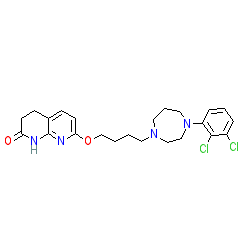Some analogues of aripiprazole (UNC9975 and UNC9994) display functional selectivity as β-arrestin–biased dopamine D2 receptor partial agonists:
Current antipsychotic drugs (APDs) show efficacy with positive symptoms, but are limited in treating negative or cognitive features of schizophrenia. While all currently FDA-approved medications target primarily the dopamine D2 receptor (D2R) to inhibit Gi/o-mediated adenylyl cyclase, a recent study has shown that many APDs affect not only Gi/o- but they can also influence β-arrestin- (βArr) mediated signaling. The ability of ligands to differentially affect signaling through these pathways is termed functional selectivity. We have developed ligands that are devoid of D2R-mediated Gi/o protein signaling, but are simultaneously partial agonists for D2R/βArr interactions. The purpose of present study was to test the effectiveness of UNC9975 or UNC9994 on schizophrenia-like behaviors in phencyclidine-treated or NR1-knockdown hypoglutamatergic mice. We have found the UNC compounds reduce hyperlocomotion in the open field, restore PPI, improve novel object recognition memory, partially normalize social behavior, decrease conditioned avoidance responding, and elicit a much lower level of catalepsy than haloperidol. These preclinical results suggest that exploitation of functional selectivity may provide unique opportunities to develop drugs with fewer side effects, greater therapeutic selectivity, and enhanced efficacy for treating schizophrenia and related conditions than medications that are currently available.
“Current antipsychotic drugs (APDs) show efficacy with positive symptoms, but are limited in treating negative or cognitive features of schizophrenia. While all currently FDA-approved medications target primarily the dopamine D2 receptor (D2R) to inhibit Gi/o-mediated adenylyl cyclase, a recent study has shown that many APDs affect not only Gi/o- but they can also influence β-arrestin- (βArr) mediated signaling. The ability of ligands to differentially affect signaling through these pathways is termed functional selectivity. We have developed ligands that are devoid of D2R-mediated Gi/o protein signaling, but are simultaneously partial agonists for D2R/βArr interactions. The purpose of present study was to test the effectiveness of UNC9975 or UNC9994 on schizophrenia-like behaviors in phencyclidine-treated or NR1-knockdown hypoglutamatergic mice. We have found the UNC compounds reduce hyperlocomotion in the open field, restore PPI, improve novel object recognition memory, partially normalize social behavior, decrease conditioned avoidance responding, and elicit a much lower level of catalepsy than haloperidol. These preclinical results suggest that exploitation of functional selectivity may provide unique opportunities to develop drugs with fewer side effects, greater therapeutic selectivity, and enhanced efficacy for treating schizophrenia and related conditions than medications that are currently available.
The recognition that GPCR ligands can be functionally selective provides us with an unprecedented opportunity to develop new drugs that selectively target the G protein or βArr pathways. In the present studies, we demonstrate that the β-arrestinergic compounds – UNC9975 and UNC9994 – are efficacious in ameliorating a broad range of schizophrenia-like behaviors in mice. Importantly, these compounds show efficacy in mice in the present study with persistent hypoglutamatergia and in the hyperdopaminergic amphetamine model (Allen et al, 2011). While we do not know the efficacy of biased compounds in treating patients, the ability to manipulate the functional selectivity of ligands may provide a unique opportunity to develop drugs with fewer side-effects, greater therapeutic selectivity, and enhanced efficacy for treating schizophrenia and related disorders than currently available medications.”

“UNC9975 binds not only the D2R (EC50 = 1.1 nM, Emax = 43 ± 0.5%) [UNC9994, (EC50 = 6.1 nM, Emax = 91 ± 3%)], but also the 5-HT2A and D3R and it has Gq activity at the former receptor. Nevertheless, it is unlikely that the action of UNC9975 in PPI is through 5-HT2A… Since UNC9975 binds the D2R and D3R with similar affinities (Allen et al, 2011) and because selectivity of ligands is poor between these receptors, behavioral responses cannot be distinguished between them. Hence, some of UNC9975’s actions attributed to the D2R may include the D3R. Another issue pertains to actions at βArr2 compared to βArr1.” The authors concluded that the “actions of UNC9975 are likely mediated primarily through βArr2 rather than βArr1”.
See also: